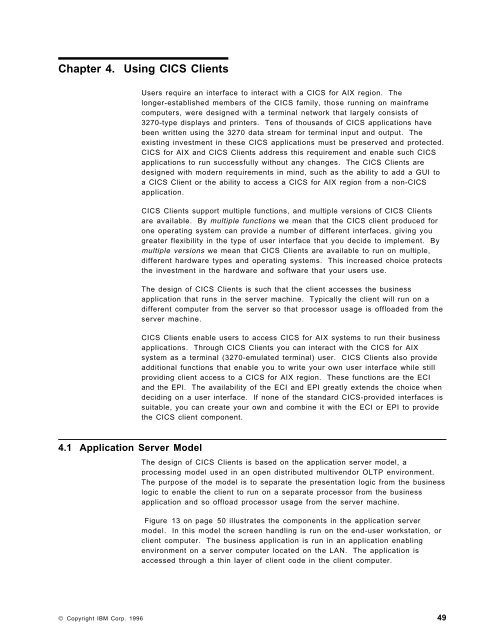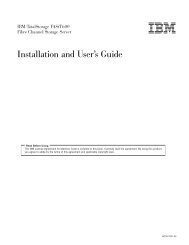Addressing OLTP Solutions with CICS: The Transaction Server ... - Ibm
Addressing OLTP Solutions with CICS: The Transaction Server ... - Ibm
Addressing OLTP Solutions with CICS: The Transaction Server ... - Ibm
You also want an ePaper? Increase the reach of your titles
YUMPU automatically turns print PDFs into web optimized ePapers that Google loves.
Chapter 4. Using <strong>CICS</strong> Clients<br />
4.1 Application <strong>Server</strong> Model<br />
Users require an interface to interact <strong>with</strong> a <strong>CICS</strong> for AIX region. <strong>The</strong><br />
longer-established members of the <strong>CICS</strong> family, those running on mainframe<br />
computers, were designed <strong>with</strong> a terminal network that largely consists of<br />
3270-type displays and printers. Tens of thousands of <strong>CICS</strong> applications have<br />
been written using the 3270 data stream for terminal input and output. <strong>The</strong><br />
existing investment in these <strong>CICS</strong> applications must be preserved and protected.<br />
<strong>CICS</strong> for AIX and <strong>CICS</strong> Clients address this requirement and enable such <strong>CICS</strong><br />
applications to run successfully <strong>with</strong>out any changes. <strong>The</strong> <strong>CICS</strong> Clients are<br />
designed <strong>with</strong> modern requirements in mind, such as the ability to add a GUI to<br />
a <strong>CICS</strong> Client or the ability to access a <strong>CICS</strong> for AIX region from a non-<strong>CICS</strong><br />
application.<br />
<strong>CICS</strong> Clients support multiple functions, and multiple versions of <strong>CICS</strong> Clients<br />
are available. By multiple functions we mean that the <strong>CICS</strong> client produced for<br />
one operating system can provide a number of different interfaces, giving you<br />
greater flexibility in the type of user interface that you decide to implement. By<br />
multiple versions we mean that <strong>CICS</strong> Clients are available to run on multiple,<br />
different hardware types and operating systems. This increased choice protects<br />
the investment in the hardware and software that your users use.<br />
<strong>The</strong> design of <strong>CICS</strong> Clients is such that the client accesses the business<br />
application that runs in the server machine. Typically the client will run on a<br />
different computer from the server so that processor usage is offloaded from the<br />
server machine.<br />
<strong>CICS</strong> Clients enable users to access <strong>CICS</strong> for AIX systems to run their business<br />
applications. Through <strong>CICS</strong> Clients you can interact <strong>with</strong> the <strong>CICS</strong> for AIX<br />
system as a terminal (3270-emulated terminal) user. <strong>CICS</strong> Clients also provide<br />
additional functions that enable you to write your own user interface while still<br />
providing client access to a <strong>CICS</strong> for AIX region. <strong>The</strong>se functions are the ECI<br />
and the EPI. <strong>The</strong> availability of the ECI and EPI greatly extends the choice when<br />
deciding on a user interface. If none of the standard <strong>CICS</strong>-provided interfaces is<br />
suitable, you can create your own and combine it <strong>with</strong> the ECI or EPI to provide<br />
the <strong>CICS</strong> client component.<br />
<strong>The</strong> design of <strong>CICS</strong> Clients is based on the application server model, a<br />
processing model used in an open distributed multivendor <strong>OLTP</strong> environment.<br />
<strong>The</strong> purpose of the model is to separate the presentation logic from the business<br />
logic to enable the client to run on a separate processor from the business<br />
application and so offload processor usage from the server machine.<br />
Figure 13 on page 50 illustrates the components in the application server<br />
model. In this model the screen handling is run on the end-user workstation, or<br />
client computer. <strong>The</strong> business application is run in an application enabling<br />
environment on a server computer located on the LAN. <strong>The</strong> application is<br />
accessed through a thin layer of client code in the client computer.<br />
© Copyright IBM Corp. 1996 49
















